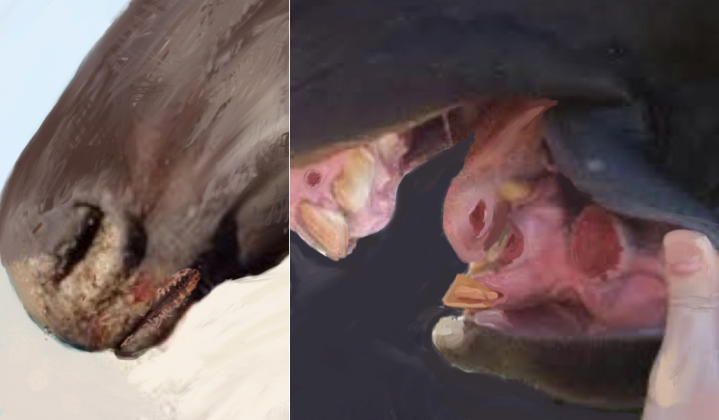 In recent months, there has been an outbreak of Vesicular Stomatitis in Colorado. Many farms are now under quarantine because of the outbreak, and there have been economic impacts on the horse industry as a whole.
In recent months, there has been an outbreak of Vesicular Stomatitis in Colorado. Many farms are now under quarantine because of the outbreak, and there have been economic impacts on the horse industry as a whole.
Vesicular Stomatitis is a disease from the viral family Rhabdoviridae and genus Vesiculovirus. Vesicular stomatitis viruses are the prototypes of the Vesiculovirus genus. They are bullet shaped and approximately 180 nm long and 75 nm wide – very, very tiny!
The New Jersey and Indiana serotypes are of particular interest in the Western hemisphere, although there are several serotypes worldwide. These two viruses stimulate very distinctive antibodies in infected animals even though they are very similar. They have both been isolated in the recent Vesicular Stomatitis recent outbreaks in the USA. The incubation period is two to eight days, and usually a fever comes and goes unnoticed before the first obvious clinical signs are noted.
Excessive salivation is the most common first clinical sign that a horse owner will notice in a horse with Vesicular Stomatitis. The medical term for excessive salivation is ptyalism. When the mouth of a horse with clinical Vesicular Stomatitis is examined, the tongue, insides of the cheeks and gums will be covered in large, irregular blistered areas where the mucosal layer is peeled off. These blisters are excruciatingly painful.
The pain causes horses to not want to swallow, eat or drink water. As such, secondary complications of dehydration and colic can also occur due to Vesicular Stomatitis. Blisters can also form on the coronary bands of the hooves that can cause lameness, as well as on the udders of mares. Some horses will also have crusty lesions on their muzzles and ventral abdomen.
Vesicular Stomatitis is not only a disease of horses. Cattle and pigs can also contract and show clinical signs of the disease. Other animals, like llamas, sheep and goats will rarely contract the disease.
 The biggest concern is that the clinical signs of Vesicular Stomatitis mimic those of Foot and Mouth disease in cloven-hooved animals such as cows and goats. Horses do not get Foot and Mouth disease. However, cattle can get both Vesicular Stomatitis and Foot and Mouth, so it is an economically important disease in food animal production areas – food animals who are sick are not gaining weight appropriately, nor are they healthy enough to ship for slaughter for human consumption. Humans can also contract Vesicular Stomatitis, and often it presents with mild flu-like symptoms – this is not very common.
The biggest concern is that the clinical signs of Vesicular Stomatitis mimic those of Foot and Mouth disease in cloven-hooved animals such as cows and goats. Horses do not get Foot and Mouth disease. However, cattle can get both Vesicular Stomatitis and Foot and Mouth, so it is an economically important disease in food animal production areas – food animals who are sick are not gaining weight appropriately, nor are they healthy enough to ship for slaughter for human consumption. Humans can also contract Vesicular Stomatitis, and often it presents with mild flu-like symptoms – this is not very common.
Vesicular Stomatitis is considered to be a high morbidity, low mortality disease – many animals will contract and get sick with Vesicular Stomatitis, but few will actually die from Vesicular Stomatitis – and usually those animals die of a secondary complication.
The virus can be transmitted either through an animal having direct contact with infected animals that are showing the obvious blister lesions, or transmitted to the animal by blood-feeding insects. In the southwestern USA, black flies are the likely vector. In endemic areas, sand flies are also vectors. Studies have shown that if insects bite and feed from the mucosal areas of infected animals, they are more likely to transmit the disease than those who feed from the haired areas.
Vesicular Stomatitis is a reportable disease in the United States. This means that if a veterinarian suspects that they are seeing animals with Vesicular Stomatitis, they are legally obligated to report those animals to their state veterinarian. State and federal animal health officials will then get involved in the testing, diagnosis, management and quarantine of the facilities that are affected by the outbreak of Vesicular Stomatitis.
There is no specific treatment for Vesicular Stomatitis, only supportive and symptomatic care. Making sure animals stay hydrated is key, so offering fresh water, along with electrolyte solutions, can be effective. Anti-inflammatory medicines may also help where pain is affecting a horse’s desire to eat. Isolate affected animals from others if at all possible. Fly management practices should be stepped up. The disease is usually self-limiting and resolves in 10-14 days. Most importantly, you need to follow the quarantine instructions from your state and federal health officials to help control the spread of the disease.
Tanis MacDonald Walker, DVM graduated from the Atlantic Veterinary College on Prince Edward Island and currently practices both small animal emergency and equine medicine in Delaware. You can email her at tanis_macdonald@hotmail.com or visit her at www.drtanis.com. You can also write to her in care of InStride Edition.


You must be logged in to post a comment Login